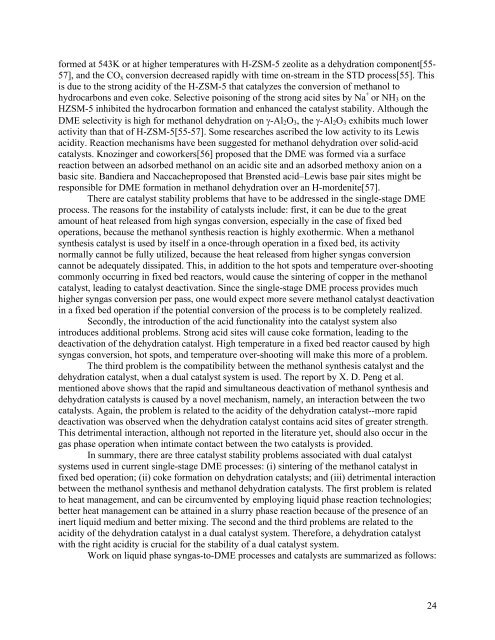Novel Design of an Integrated Pulp Mill Biorefinery for the ...
Novel Design of an Integrated Pulp Mill Biorefinery for the ...
Novel Design of an Integrated Pulp Mill Biorefinery for the ...
Create successful ePaper yourself
Turn your PDF publications into a flip-book with our unique Google optimized e-Paper software.
<strong>for</strong>med at 543K or at higher temperatures with H-ZSM-5 zeolite as a dehydration component[55-<br />
57], <strong>an</strong>d <strong>the</strong> COx conversion decreased rapidly with time on-stream in <strong>the</strong> STD process[55]. This<br />
is due to <strong>the</strong> strong acidity <strong>of</strong> <strong>the</strong> H-ZSM-5 that catalyzes <strong>the</strong> conversion <strong>of</strong> meth<strong>an</strong>ol to<br />
hydrocarbons <strong>an</strong>d even coke. Selective poisoning <strong>of</strong> <strong>the</strong> strong acid sites by Na + or NH3 on <strong>the</strong><br />
HZSM-5 inhibited <strong>the</strong> hydrocarbon <strong>for</strong>mation <strong>an</strong>d enh<strong>an</strong>ced <strong>the</strong> catalyst stability. Although <strong>the</strong><br />
DME selectivity is high <strong>for</strong> meth<strong>an</strong>ol dehydration on γ-Al2O3, <strong>the</strong> γ-Al2O3 exhibits much lower<br />
activity th<strong>an</strong> that <strong>of</strong> H-ZSM-5[55-57]. Some researches ascribed <strong>the</strong> low activity to its Lewis<br />
acidity. Reaction mech<strong>an</strong>isms have been suggested <strong>for</strong> meth<strong>an</strong>ol dehydration over solid-acid<br />
catalysts. Knozinger <strong>an</strong>d coworkers[56] proposed that <strong>the</strong> DME was <strong>for</strong>med via a surface<br />
reaction between <strong>an</strong> adsorbed meth<strong>an</strong>ol on <strong>an</strong> acidic site <strong>an</strong>d <strong>an</strong> adsorbed methoxy <strong>an</strong>ion on a<br />
basic site. B<strong>an</strong>diera <strong>an</strong>d Naccacheproposed that Brønsted acid–Lewis base pair sites might be<br />
responsible <strong>for</strong> DME <strong>for</strong>mation in meth<strong>an</strong>ol dehydration over <strong>an</strong> H-mordenite[57].<br />
There are catalyst stability problems that have to be addressed in <strong>the</strong> single-stage DME<br />
process. The reasons <strong>for</strong> <strong>the</strong> instability <strong>of</strong> catalysts include: first, it c<strong>an</strong> be due to <strong>the</strong> great<br />
amount <strong>of</strong> heat released from high syngas conversion, especially in <strong>the</strong> case <strong>of</strong> fixed bed<br />
operations, because <strong>the</strong> meth<strong>an</strong>ol syn<strong>the</strong>sis reaction is highly exo<strong>the</strong>rmic. When a meth<strong>an</strong>ol<br />
syn<strong>the</strong>sis catalyst is used by itself in a once-through operation in a fixed bed, its activity<br />
normally c<strong>an</strong>not be fully utilized, because <strong>the</strong> heat released from higher syngas conversion<br />
c<strong>an</strong>not be adequately dissipated. This, in addition to <strong>the</strong> hot spots <strong>an</strong>d temperature over-shooting<br />
commonly occurring in fixed bed reactors, would cause <strong>the</strong> sintering <strong>of</strong> copper in <strong>the</strong> meth<strong>an</strong>ol<br />
catalyst, leading to catalyst deactivation. Since <strong>the</strong> single-stage DME process provides much<br />
higher syngas conversion per pass, one would expect more severe meth<strong>an</strong>ol catalyst deactivation<br />
in a fixed bed operation if <strong>the</strong> potential conversion <strong>of</strong> <strong>the</strong> process is to be completely realized.<br />
Secondly, <strong>the</strong> introduction <strong>of</strong> <strong>the</strong> acid functionality into <strong>the</strong> catalyst system also<br />
introduces additional problems. Strong acid sites will cause coke <strong>for</strong>mation, leading to <strong>the</strong><br />
deactivation <strong>of</strong> <strong>the</strong> dehydration catalyst. High temperature in a fixed bed reactor caused by high<br />
syngas conversion, hot spots, <strong>an</strong>d temperature over-shooting will make this more <strong>of</strong> a problem.<br />
The third problem is <strong>the</strong> compatibility between <strong>the</strong> meth<strong>an</strong>ol syn<strong>the</strong>sis catalyst <strong>an</strong>d <strong>the</strong><br />
dehydration catalyst, when a dual catalyst system is used. The report by X. D. Peng et al.<br />
mentioned above shows that <strong>the</strong> rapid <strong>an</strong>d simult<strong>an</strong>eous deactivation <strong>of</strong> meth<strong>an</strong>ol syn<strong>the</strong>sis <strong>an</strong>d<br />
dehydration catalysts is caused by a novel mech<strong>an</strong>ism, namely, <strong>an</strong> interaction between <strong>the</strong> two<br />
catalysts. Again, <strong>the</strong> problem is related to <strong>the</strong> acidity <strong>of</strong> <strong>the</strong> dehydration catalyst--more rapid<br />
deactivation was observed when <strong>the</strong> dehydration catalyst contains acid sites <strong>of</strong> greater strength.<br />
This detrimental interaction, although not reported in <strong>the</strong> literature yet, should also occur in <strong>the</strong><br />
gas phase operation when intimate contact between <strong>the</strong> two catalysts is provided.<br />
In summary, <strong>the</strong>re are three catalyst stability problems associated with dual catalyst<br />
systems used in current single-stage DME processes: (i) sintering <strong>of</strong> <strong>the</strong> meth<strong>an</strong>ol catalyst in<br />
fixed bed operation; (ii) coke <strong>for</strong>mation on dehydration catalysts; <strong>an</strong>d (iii) detrimental interaction<br />
between <strong>the</strong> meth<strong>an</strong>ol syn<strong>the</strong>sis <strong>an</strong>d meth<strong>an</strong>ol dehydration catalysts. The first problem is related<br />
to heat m<strong>an</strong>agement, <strong>an</strong>d c<strong>an</strong> be circumvented by employing liquid phase reaction technologies;<br />
better heat m<strong>an</strong>agement c<strong>an</strong> be attained in a slurry phase reaction because <strong>of</strong> <strong>the</strong> presence <strong>of</strong> <strong>an</strong><br />
inert liquid medium <strong>an</strong>d better mixing. The second <strong>an</strong>d <strong>the</strong> third problems are related to <strong>the</strong><br />
acidity <strong>of</strong> <strong>the</strong> dehydration catalyst in a dual catalyst system. There<strong>for</strong>e, a dehydration catalyst<br />
with <strong>the</strong> right acidity is crucial <strong>for</strong> <strong>the</strong> stability <strong>of</strong> a dual catalyst system.<br />
Work on liquid phase syngas-to-DME processes <strong>an</strong>d catalysts are summarized as follows:<br />
24

















